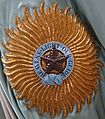Order of the Star of India facts for kids
Quick facts for kids Order of the Star of India |
|
|---|---|
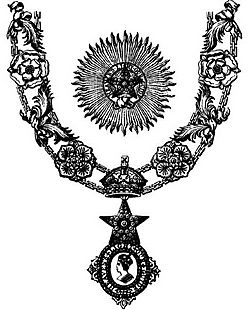
Insignia of a Knight Grand Commander of the Order of the Star of India
|
|
| Awarded by the Queen of the United Kingdom | |
| Type | Order |
| Motto | HEAVEN'S LIGHT OUR GUIDE |
| Awarded for | At the monarch's pleasure |
| Status | Not awarded since 1947 Dormant order since 2009 |
| Sovereign | Her Majesty Queen Elizabeth II of the United Kingdom |
| Grades | Knight Grand Commander(GCSI) Knight Commander(KCSI) Companion(CSI) |
| Former grades | Knight Companion |
| Precedence | |
| Next (higher) | Order of the Bath |
| Next (lower) | Order of St. Michael and St. George |
Ribbon bar of the Star of India |
|
- The article is about the order of chivalry known as "Star of India". For other items of the same name, please see disambiguation at Star of India.
The Most Exalted Order of the Star of India was a special award created by Queen Victoria in 1861. It was a type of order of chivalry, which is a group of people honored for their service. This order was created to recognize important people in India and those who served there.
The Order had three main levels of membership:
- Knight Grand Commander (GCSI)
- Knight Commander (KCSI)
- Companion (CSI)
The motto of the Order is Heaven's light our guide. The "Star of India" was also an important symbol. It even appeared on the flag of the Viceroy of India, who was the highest British official in India.
No new members have joined the Order since 1947. This was when India became independent from British rule. The last living member of the Order passed away in 2009. This means the Order is now "dormant," which means it still exists but no one is currently a member.
Contents
History of the Star of India Order
After a big rebellion in India in 1857, the British government wanted to create a new way to honor important people. This included Indian Princes and Chiefs, as well as British officers and leaders who worked in India.
So, on June 25, 1861, Queen Victoria officially announced the creation of "The Most Exalted Order of the Star of India." Its purpose was to "reward conspicuous merit and loyalty." This meant it honored people who showed great skill and loyalty to the British Crown.
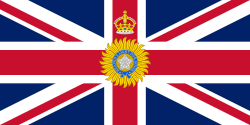
First Members of the Order
The very first people to be appointed to the Order were important figures. They included members of the British Royal Family and many powerful Indian rulers. Some of these first members were:
- HRH The Prince Consort (Queen Victoria's husband)
- HRH The Prince of Wales (who later became King)
- The Nizam of Hyderabad, a very important Indian ruler
- The Maharaja of Gwalior
- The Maharaja of Indore
- The Nawab Begum of Bhopal (a powerful female ruler)
- Several top British military leaders and governors in India
Later, in 1877, another order called the Order of the Indian Empire was created. It was similar but had more members. This meant the Order of the Star of India remained more exclusive.
The Order After India's Independence
Appointments to the Order stopped after August 14, 1947. This was the day before India gained its independence. Even though no new members have been added, the Order has never been officially ended.
Queen Elizabeth II became the "Sovereign" (the head) of the Order in 1952. She remains the Sovereign today. However, there are no living members left.
- The last leader of the Order, Earl Mountbatten of Burma, died in 1979.
- The last Knight Grand Commander (GCSI), the Maharaja of Travancore, died in 1991.
- The last Knight Commander (KCSI), the Maharaja of Alwar, died in 2009.
- The last Companion (CSI), Vice-Admiral Ronald Brockman, died in 1999.
How the Order Was Structured
The British King or Queen was always the "Sovereign" of the Order. This meant they were its highest leader. The next most important person was the "Grand Master." This role was always held by the Viceroy of India.
When the Order first started in 1861, it only had one level of members called "Knights Companions." But in 1866, it was changed to have three levels. The highest level was called "Knights Grand Commanders." This name was chosen instead of "Knights Grand Cross" to be respectful to the non-Christian Indian members.
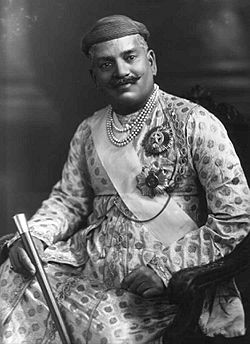
Who Could Join the Order?
Many different people were chosen to join the Order. This included former Viceroys and other high-ranking British officials who had served in India for a long time.
Rulers of Indian Princely States were also eligible. Some of these states were so important that their rulers were almost always made Knights Grand Commanders. These included rulers like the Nizam of Hyderabad, the Maharaja of Mysore, and the Maharaja of Gwalior.
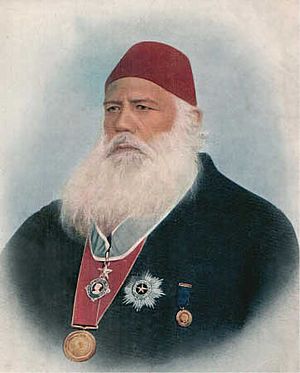
Rulers from other countries in Asia and the Middle East could also be appointed. This included leaders like the Emir of Kuwait, the Khedive of Egypt, and the King of Bhutan.
Women in the Order
Women could also be members of the Order. They were called "Knights" just like the men. The first woman to join was HH Nawab Sikandar Begum Sahiba, the Nawab Begum of Bhopal, in 1861. Later, Queen Mary was also made a Knight Grand Commander in 1911.
Images for kids
-
George V investing an Indian Prince with The Star of India, 14th December, 1911 by William Barnes Wollen
-
Victor Bruce, 9th Earl of Elgin, Viceroy of India, in the robes of the Order of the Star of India
-
The Maharaja of Cochin wearing the mantle of the Order for the occasion of King Edward VII's Delhi Durbar of 1903
See also
 In Spanish: Orden de la Estrella de la India para niños
In Spanish: Orden de la Estrella de la India para niños




